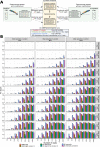RNA modifications detection by comparative Nanopore direct RNA sequencing
- PMID: 34893601
- PMCID: PMC8664944
- DOI: 10.1038/s41467-021-27393-3
RNA modifications detection by comparative Nanopore direct RNA sequencing
Abstract
RNA molecules undergo a vast array of chemical post-transcriptional modifications (PTMs) that can affect their structure and interaction properties. In recent years, a growing number of PTMs have been successfully mapped to the transcriptome using experimental approaches relying on high-throughput sequencing. Oxford Nanopore direct-RNA sequencing has been shown to be sensitive to RNA modifications. We developed and validated Nanocompore, a robust analytical framework that identifies modifications from these data. Our strategy compares an RNA sample of interest against a non-modified control sample, not requiring a training set and allowing the use of replicates. We show that Nanocompore can detect different RNA modifications with position accuracy in vitro, and we apply it to profile m6A in vivo in yeast and human RNAs, as well as in targeted non-coding RNAs. We confirm our results with orthogonal methods and provide novel insights on the co-occurrence of multiple modified residues on individual RNA molecules.
© 2021. The Author(s).
Conflict of interest statement
E.B. is a paid consultant and shareholder of O.N.T. T.K. is a co-founder of Abcam and a co-founder of STORM Therapeutics Limited. P.P.A. was a Research Scientist and paid Consultant at STORM Therapeutics Limited. T.L. is a paid consultant of STORM Therapeutics Limited and received reimbursement of registration fees from ONT to speak at an event. A.L. received free consumables from ONT during the project and is currently an employee of ONT. The remaining authors declare no competing interests.
Figures






References
-
- Dominissini D, et al. Topology of the human and mouse m6A RNA methylomes revealed by m6A-seq. Nature. 2012;485:201–206. - PubMed
Publication types
MeSH terms
Substances
Grants and funding
LinkOut - more resources
Full Text Sources
Other Literature Sources
Molecular Biology Databases
Research Materials
Miscellaneous

